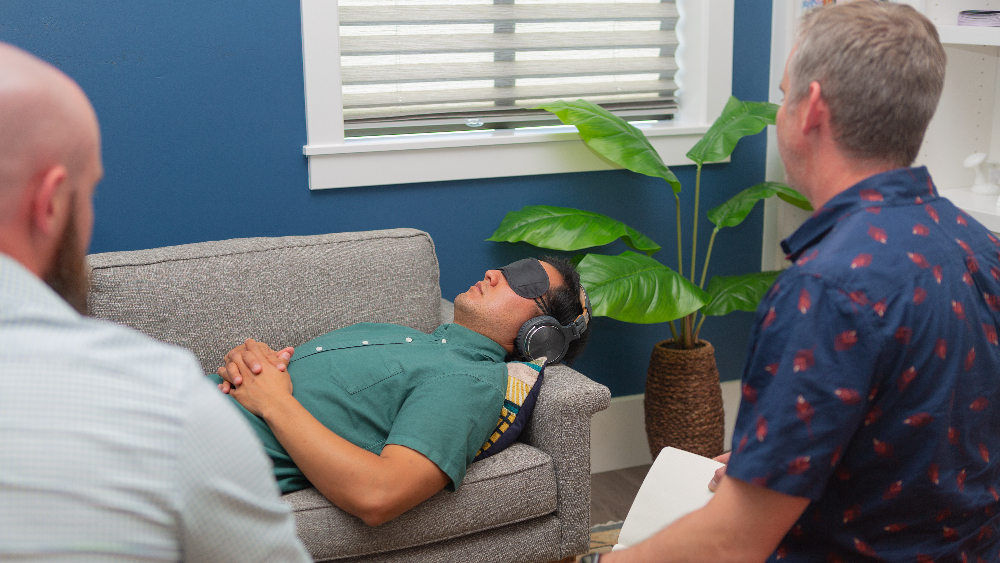I Took a Psychedelic-Assisted Therapy Course. Here’s What I Learned
Psychedelics can feel as important as the birth of a child or the death of a parent, and can change people’s lives almost as much. I know this firsthand. After psychedelic-assisted therapy sessions with a licensed therapist over about seven years, I’m a tiny bit calmer and a little bit more present for the people in my life.
Psychedelics can also feel insanely overwhelming–like climbing into an active volcano or surfing a big wave. Earlier in my life, riding some big breaks by myself, I got knocked off my surfboard–metaphorically speaking. It was scary.
Today, these powerful medicines are on the verge of becoming legal. There are plans for healing centers for mushroom journeys in Colorado and Oregon, and doctor-prescribed, MDMA-assisted therapy nationwide.
Most of the time, the new laws will require people to take psychedelics sitting next to someone who is sober and who knows what a trip feels like–is familiar with the way the waves can break. These sitters are called, variously, space holders, facilitators, practitioners, guides, shamans, psychiatrists or therapists. These caregivers will watch over people as they do psychedelic-assisted therapy and try to maximize the benefits and minimize the harms.
Right now, interest in psychedelic-assisted therapy is through the roof. And so the world is going to need thousands of qualified caregivers. And so trainings are popping up around the world to meet this vast need.
READ MORE: Tens of Thousands of Trained Psychedelic Practitioners Needed, Experts Say
Psychedelic Therapy Training as a Key to Providing Hope
Psychedelic-assisted therapy, said a woman on a recent Zoom call, gives us a “growing and enhanced openness to what it means to be human. We can see the full range of our experience.”
This video call was for a course I took called the Fundamentals of Psychedelic-Assisted Therapy. It was hosted and led by Numinus.
Numinus is a Canadian company looking to train thousands of people to do MDMA and psilocybin-assisted therapy to treat PTSD and mood disorders like depression and anxiety—as psychedelic-assisted therapy becomes legal.
To take the strongest piece of evidence that psychedelic-assisted therapy can help: MAPS completed a big study testing out MDMA-assisted psychotherapy for PTSD. By the end of the study, 72 percent of people no longer qualified for a PTSD diagnosis.
The rule will likely be that two people will need to be in the room while clients are navigating these non-ordinary states. One of those people will likely need to be a licensed therapist. I want to be the second person in the room.
GET INVOLVED: Psychedelic-Assisted Therapy Certifications and Training
A Rich Psychedelic-Assisted Therapy Training
HealingMaps has partnered with Numinus because they have the best online psychedelic trainings going today. The Numinus training was academically rich while also being warm and personal. I felt more relaxed and looked more toward these trainings than nearly any other training I’ve ever done. (When I get trained as a medical professional, it’s often cold and cut-and-dry.)
My training lasted eight weeks. The pace was rigorous, but not overwhelming. There were three main parts:
At-home Work
There was reading, journaling, exercises, and videos with people like Gabor Maté, Peter Levine and Dick Schwartz.
Small Group Discussions
We Zoomed once a week for an hour with two other students. The class had licensed therapists and doctors as well as people just starting out. We role-played being a sitter and gave feedback. My group mates were deep, open people who knew a lot more about sitting and therapy than I do.
A Three-hour Live Session
We Zoomed once a week with our larger group of a couple dozen students. My training was led by Devon Christie, a medical doctor, professor and therapist who had clearly been in a lot of ayahuasca ceremonies, studied a lot of Western medicines, sat through a lot of therapy, was an investigator for the MAPS trial for MDMA-assisted psychotherapy for PTSD, and was an open-hearted presence in our training. Also teaching were Deanna Rogers and Steve Thayer, facilitators with years of experience in psychedelic guiding. The Numinus team was thoughtful, professional, and brought authenticity, candor, and heart to the course.
RELATED: Psychedelic Therapist Training: How to Become a Certified Psychedelic Therapist

Things I Learned
Indigenous Roots
We learned about how indigenous cultures use psychedelics in a variety of ways—usually in a container–and about the difference between honoring indigenous wisdom and appropriating it—a fine line. We learned to respect diversity. For example: the Blackfeet, I was surprised to learn, used Jimson weed in their ceremonies. (Jimson is datura, demonized in the West as toxic, as devil’s trumpet. To the Blackfeet, it’s a rite of passage. An example of how one culture’s poison is another’s medicine.)
Body, Body, Body
Westerners use the word psychedelics, which means mind-manifesting, which frames tripping as just another form of thinking. Psychotherapy, too, focuses on the brain: ruminations, worries, stories.
The Numinus training shifts the balance of psychedelics toward the body, which I’ve personally found to be more useful.
Numinus trained us to direct the client’s attention—over and over—to the sensations of their breath, flesh and bone. To orient and ground the client through breathing exercises, body scans and even self-hugs. Ask them often what they feel, where they feel it, and what comes to mind when that sensation pops up. And then suggest they just sit with the feelings: not to try and fix anything. They offer an entire course on this practice alone as well: Embodied Inquiry: A New Methodology for Psychedelic-Assisted Therapy – Numinus
Sound and Space
Music is one of the harder and more crucial jobs for a sitter. I had a DJ in my small group, and we traded tips on how to program a playlist for a session. Check out Garth Stevenson. Also: silence is key. When someone is on a psychedelic, sometimes the most useful thing you can say is nothing. We learned how to spruce up your space for a session. I realized I should probably move the TV out.
Preparation and Integration
A psychedelic journey is not like getting on an airplane, where the passenger is passive. It’s more like rafting a river. If you’re the guide, it might help to get your client a lifejacket, and teach them a little about eddies and rapids and put-ins and take-outs.
Trauma
This class helped me define trauma, expand my definition of it, and instructed us on how to work with trauma in a psychedelic session.
One of the keys is to play the edges, is how I’d put it. Don’t start a session saying, “Let’s talk about the car crash.” Go with something softer, like, “What do you want to work on?” If they say, “Car crash,” ease in with something like “What was going on that morning?” Then you see how far they’re willing to dive in, always being ready to back out if things get too intense. (I’m a medical professional, not a therapist, so I won’t take the lead on any deep trauma work.)
Relationship-centered Approach
More than, say, a visit to the dentist, a psychedelic session is about a connection between the sitter and the journeyer. So we talked about how you present yourself to a client, and how you connect without getting enmeshed. After all, you’re not exactly their friend, but you want to be friendly: open, welcoming, empathetic. We talked about ethics, about the power dynamics between a guide and the client, and practiced setting boundaries. For example, how to touch clients in a safe way (a reassuring hand on the shoulder—and that’s about as far as it should go).
The Inner Healer
Here was my favorite part. Numinus teaches: the health professional is not a shaman or a guru. You don’t heal. You provide a space for people to connect with themselves and their own Inner Healing intelligence. A belief in the Inner Healer absolves the sitter of any sort of messiah complex. The role of a guide is less about rushing around with flashing lights and sirens trying to fix people. Mostly, we sit quietly in a room with everyone just as we are.
Why Trainings Like These Are Important
These trainings are important because the helping professions—nurses, doctors, teachers, therapists—are feeling more strained than ever, more helpless, more stressed. We’re watching a flood of suffering overrun our banks and we feel like all we have to bail ourselves out are measuring cups.
I’m licensed in emergency medicine. When I was on the ambulance answering 911 calls here in Colorado, bodies got injured by lots of trauma like car crashes and assaults.
We were able to fix a few things. Even more often, though, I’d speed around a corner and find that my patients’ bodies seemed to be falling apart for no super obvious reason: men dying of overdoses and alcohol use disorder, women cutting their forearms, and everywhere all day what we called psychs: people with mental illness so bad someone called us. These collapsing bodies were a symptom not of traumatic incidents, like stabbings or strokes, but of a crumbling society.
We knew we couldn’t fix much of this wreckage. It made me sad.
Psychedelics as Tools
Psychedelics can help us address the kinds of injuries that stitches and neck braces can’t. I’ve seen some wonderful things as an informal sitter over the decades. People weeping at the sudden realization of the beauty of the world, a man finding his purpose in life, happiness about the way things actually are. (And some not-great things, too: people terrified, mostly. Part of why training is important.)
Many Schools
In medicine, we get trained on every drug we give out. And a lot of people involved in psychedelics suggest following a lineage of some kind. Doesn’t have to be Western medicine: My buddy who is a peyote roadman follows the lead of generations of Indian healers. Lots of ayahuasca facilitators follow generations of Shipibo or Huni Kuin. One friend listens to the advice of the mushrooms themselves.
One of the key things I came away with from the Numinus training was not so much any technique or method. I remembered I don’t have to go it alone. No one has to give psychedelics in a vacuum. There are deep wells of help, support, training, and colleagues eager to teach and learn.
Truly great subjects are bottomless. Psychedelic-assisted psychotherapy goes right to the core of our being. Truly great trainings don’t feel like an obligation, a box to be checked. This Numinus training felt like a joy.
I highly recommend giving this program a shot if you are interested in the field of psychedelic-assisted therapy, and want to consider adding “space-holding” to your skill set. As a proud partner of this training organization, Healing Maps can offer our community members 15% off using our code HEALINGMAPS15.
GET STARTED: Fundamentals of Psychedelic-Assisted Therapy – Numinus



